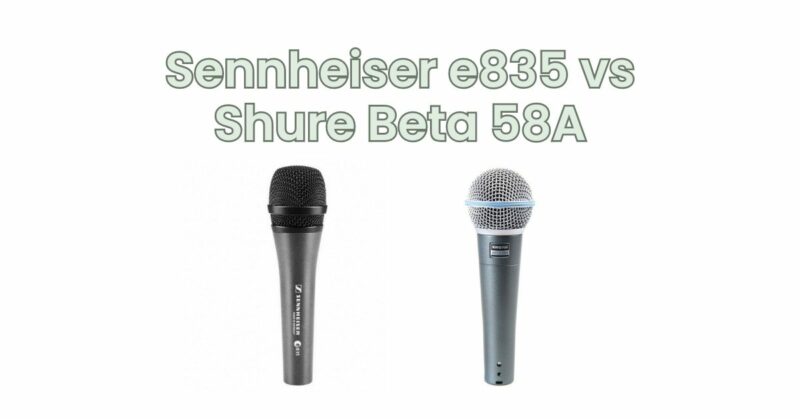Dynamic vocal microphones are essential tools for live performances, delivering clear and powerful vocals on stage. The Sennheiser e835 and the Shure Beta 58A are two popular choices among musicians and sound engineers. In this article, we will compare the Sennheiser e835 and the Shure Beta 58A, examining their features, sound characteristics, and suitability for various vocal applications.
- Sennheiser e835:
- Shure Beta 58A:
Sennheiser e835 Overview: The Sennheiser e835 is a dynamic vocal microphone known for its solid build quality and clear sound reproduction. It features a cardioid polar pattern, which effectively isolates the desired sound source while minimizing background noise and feedback. The e835 has a frequency response tailored to enhance vocal presence and clarity, making it suitable for a wide range of vocal styles and genres.
Shure Beta 58A Overview: The Shure Beta 58A is a dynamic vocal microphone that offers excellent sound quality, durability, and reliability. It features a supercardioid polar pattern, providing increased off-axis rejection and reducing feedback. The Beta 58A has a tailored frequency response with a slight emphasis on the midrange frequencies, delivering warm and articulate vocals. It is well-regarded for its ability to cut through the mix and deliver clear, detailed sound.
Sound Characteristics: The Sennheiser e835 delivers a clear and balanced sound with a slight boost in the upper midrange frequencies, enhancing vocal presence. It offers a smooth and natural sound reproduction, capturing vocals with accuracy and detail. The e835 excels in reproducing a wide dynamic range, allowing for expressive performances.
The Shure Beta 58A provides a warm and focused sound, emphasizing the midrange frequencies for enhanced vocal clarity. It offers a tight and controlled pickup pattern, reducing off-axis noise and background sound. The Beta 58A has a strong presence in the mix, making it suitable for vocals that need to cut through a dense mix or live band environment.
Build Quality and Design: The Sennheiser e835 features a durable metal construction, ensuring longevity and reliability even in demanding live performance situations. It has a robust grille design that protects the microphone capsule from damage caused by handling and plosive sounds. The e835 has a comfortable grip and a solid feel in the hand.
The Shure Beta 58A also boasts a sturdy construction, designed to withstand rigorous use on stage. It features a hardened steel mesh grille that provides excellent durability and protection. The Beta 58A has an ergonomic design with a tapered handle, allowing for a comfortable grip during performances.
Applications and Versatility: Both microphones excel in live vocal applications, including stage performances, concerts, and public speaking events. The Sennheiser e835 is suitable for a wide range of vocal styles and genres, from smooth and melodic singing to energetic and dynamic performances. It can handle high sound pressure levels, making it suitable for close-miking loud sources.
The Shure Beta 58A is particularly well-suited for rock, pop, and R&B vocals, where its focused sound and ability to cut through the mix are highly advantageous. It is also suitable for studio recording applications, including vocals, podcasting, and voice-over work.
Price and Value: In terms of pricing, the Sennheiser e835 is generally more affordable compared to the Shure Beta 58A. The e835 offers excellent value for its performance, build quality, and reputation in the industry. The Shure Beta 58A is positioned at a slightly higher price point, reflecting its premium sound and construction.
Choosing between the Sennheiser e835 and the Shure Beta 58A depends on your specific vocal requirements, preferences, and budget. Both microphones are highly regarded in the industry, offering reliable performance and clear sound reproduction. The e835 delivers a balanced and natural sound, while the Beta 58A offers a warmer tone with increased presence. Consider your vocal style, intended applications, and budget to determine which microphone best suits your needs and preferences.


